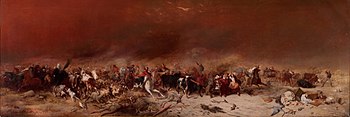
Back Rikisi no Awto AMI تاريخ أستراليا Arabic Historia d'Australia AST Avstraliya tarixi Azerbaijani Гісторыя Аўстраліі Byelorussian История на Австралия Bulgarian অস্ট্রেলিয়ার ইতিহাস Bengali/Bangla Història d'Austràlia Catalan Dějiny Austrálie Czech Hanes Awstralia Welsh
This article may be too long to read and navigate comfortably. When this tag was added, its readable prose size was 35,000 words. (June 2023) |
| This article is part of a series on the |
| History of Australia |
|---|
 |
|
|
| This article is part of a series on the |
| Culture of Australia |
|---|
 |
| Society |
| Arts and literature |
| Other |
| Symbols |
|
Australia portal |
The history of Australia is the history of the land and peoples which now comprise the Commonwealth of Australia. The modern nation came into existence on 1 January 1901 as a federation of former British colonies. The human history of Australia, however, commences with the arrival of the first ancestors of Aboriginal Australians by sea from Maritime Southeast Asia between 50,000 and 65,000 years ago, and continues to the present day multicultural democracy.
Aboriginal Australians settled throughout continental Australia and many nearby islands. The artistic, musical and spiritual traditions they established are among the longest surviving in human history.[1] The ancestors of today's ethnically and culturally distinct Torres Strait Islanders arrived from what is now Papua New Guinea around 2,500 years ago, and settled the islands on the northern tip of the Australian landmass.
Dutch navigators explored the western and southern coasts in the 17th century and named the continent New Holland. Macassan trepangers visited Australia's northern coasts from around 1720, and possibly earlier. In 1770, Lieutenant James Cook charted the east coast of Australia and claimed it for Great Britain. He returned to London with accounts favouring colonisation at Botany Bay (now in Sydney). The First Fleet of British ships arrived at Botany Bay in January 1788 to establish a penal colony. In the century that followed, the British established other colonies on the continent, and European explorers ventured into its interior. This period saw a decline in the Aboriginal population and the disruption of their cultures due to introduced diseases, violent conflict and dispossession of their traditional lands. From 1871, the Torres Strait Islanders welcomed Christian Missionaries, and the islands were later annexed by Queensland, choosing to remain a part of Australia when Papua New Guinea gained independence from Australia a century later.
Gold rushes and agricultural industries brought prosperity. Transportation of British convicts to Australia was phased out from 1840 to 1868. Autonomous parliamentary democracies began to be established throughout the six British colonies from the mid-19th century. The colonies voted by referendum to unite in a federation in 1901, and modern Australia came into being. Australia fought as part of British Empire and later Commonwealth in the two world wars and was to become a long-standing ally of the United States through the Cold War to the present. Trade with Asia increased and a post-war immigration program received more than 7 million migrants from every continent. Supported by immigration of people from almost every country in the world since the end of World War II, the population increased to more than 25.5 million by 2021, with 30 per cent of the population born overseas.
- ^ Rasmussen, M.; et al. (22 September 2011). "An Aboriginal Australian Genome Reveals Separate Human Dispersals into Asia". Science. 334 (6052): 94–98. Bibcode:2011Sci...334...94R. doi:10.1126/science.1211177. PMC 3991479. PMID 21940856.
© MMXXIII Rich X Search. We shall prevail. All rights reserved. Rich X Search